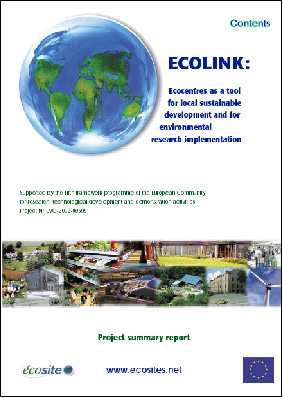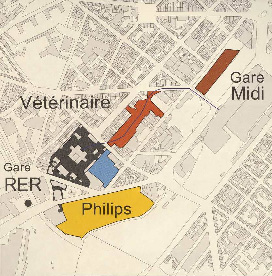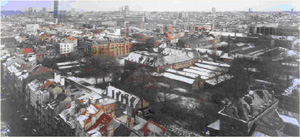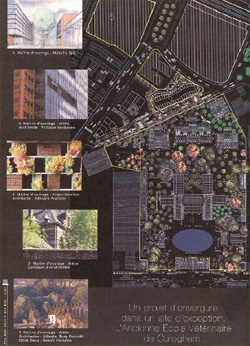 |
 |
 |
 |
 |
 |
 |
 |
 |
 |
 |
 |
Project description
Name der Fallstudie
E.C.U.B.-Projekt
Description of context
At the beginning of the project in 1998-1999, the general context is the promotion of sustainable development at European but also national and regional levels. The developer (ARTIM) got influenced. Nevertheless, they didn?t have any concrete text of references in mind when they launched the project.
The Brussels Capital Region?s promotion of sustainable development and particularly the support of the IBGE-BIM (Brussels Institute for Management of the Environment) enhance the development of the project in a sustainable way.
In 1998-1999, the general context appears favourable to sustainable development but not constraining.
Later during the investigation of the ECUB project, IBGE-BIM organized a conference on Ecosites or Eco-Centres and took an active part in the Ecolink European project.

European Project ECOLINK, summary report, cover page
In June 2002 IBGE-BIM, in cooperation with Euro-MP Yves Pietrasanta, organised a conference on Ecosites or Eco-Centres at Brussels, bringing together more than 150 people from the four corners of Europe, Asia and United States.
"Ten years after the Rio Summit, although sustainable development is nearly universally recognized as essential, the move from theory to practice appears to have fallen short. One of the concrete and practical manifestations of the concept is probably that of the Ecosites or Eco-Centres."
http://www.ibgebim.be/english/contenu/content.asp?ref=1789&Highlight=%20Cureghem
The conference was the setting for contacts that will be the basis for a partnership and networking of the heads of the various ecosites.
In 2003, the networking of European ecosites continued and was formalized under the Ecolink European project and its four practical workshops.
Description of project - background
An homogeneous unit of 20 buildings in Brussels, which was a veterinary surgeon school inaugurated in 1910, was left in a neglected state since the departure of the school in 1991. In 1998, a private agency got interested in the site to establish its offices in it.
ARTIM agency was created, aware of the need of a global project proposal for the whole site?s reassignment, park and buildings. The ECUB project started.

Localisation of the ECUB project (V鴩rinaire) in the Cureghem district, Brussels
The project is located in the Cureghem district whose image is deeply marked by industries departure and urban decline.

Picture of the site, Old veterinary school of Cureghem. General view of the ECUB project, master plan
The project developed as an "Eco-centre" that will combine different functions and that will contribute to the neighbourhood revitalization. The IBGE-BIM (Brussels Institute for Management of the Environment) got involved in it and deliberated the transfer of their offices on the site.
If the concern was mainly environmental (eco-building) the program was progressively specified into a more holistic and sustainable one: reduce the energy consumption, mix functions, open green spaces to the public, preserve cultural heritage, etc?
Description of project - objectives/aims
At the very beginning, the project has essentially a patrimonial and financial purpose. An environmental aim was quickly added. Progressively, economic and mainly social goals were included. The project evolved as a rehabilitation action that could spread its influence and revitalize the neighbourhood. Links with the context were analysed more in depth.
After a long period of inception, project?s goals have been summed in 10 points. Some of these are in between quantitative and qualitative.
I Eco-management
II Energy consumption decrease
III Eco-construction principles
IV Insertion of the project in its social context
V Implication of "Social integration companies" in the project.
VI Public information
VII Project's financial viability.
VIII Formalization of the Brussels Corporate Eco-dynamism Label and Charter (see Description of tool, other tools implemented)
IX Management of the green areas surrounding the buildings, using them as an urban park reinforcing the existing Brussels green network.
X Preservation and valorisation of the cultural architectural heritage of the site.
Description of project - time interval and stages
From 1998 to 2002, the concept was investigated. ARTIM made many preliminaries contacts with authorities in charge of the different aspects of the project. They received advices and became aware of regulations in force at the different levels (district, municipality, town, region,...).
Progressively, they discovered new tools that helped them at the conception/design stage clarifying goals and finding parts of the solution.
During this period, the IBGE-BIM, public partner of the project, stressed on inter-connections with the district and its social context as well as on the management of the green areas. Socio-town-planning analysis (6) were developed to better understand the features and the role of the project in the particular social context of the Cureghem district.
In 2000, an architecture competition was organised for some buildings and green spaces. HQE and BREEAM were used to assess different sustainable aspects shown off by the participants.
In 2002, the site development program was clarified.

General view of the ECUB project, master plan
In November 2003, the project felled through because the buildings were not available for an eco-site project any more: the site has been dismembered and sold at different private owners.
Description of project - financing
The private agency ARTIM was supposed to assume the project as building owner and project developer: they imagined the transformation of the site, searched investors and occupants for the different buildings.
ARTIM was also the architectural coordinator and set up an architectural competition for the different buildings and the park, and managed the different stages of the project. The agency also involved itself as architect for some buildings.
The IBGE-BIM worked in partnership with ARTIM on the project. They were aware of the need of an eco-centre in Brussels and they took over the cost of some studies.
The Anderlecht municipality gets interested in economical aspects: ?too much projects turn wrong because of bad financial management.? The municipality will give its official support to the project, when ARTIM will demonstrate the project?s viability.
As the site contains a large park, the ECUB project could take part into the Brussels green network within the framework of the European project INTEREG. Opening the park to public could thus lead to an extra financial support for studies, etc.
But in November 2003, the project felled through, the site was dismembered and sold (private businesses). The managers of the IBGE-BIM, (public partner of the project), put in evidence the weak means of actions they have concerning the real estate availability. Public control over the project is essential and a simple lease does not provide that guarantee. Partnerships, including financial partnerships, that help to ensure this control, are being sought.
Description of project - other sectors involved
This project aims to approach different facets of sustainability. Different tools enable to investigate different aspects but the difficulty is to manage them as interconnections are complex.
For instance, energy challenges are conflicting with patrimonial conservation; the opening of the surrounding park to district's inhabitants is conflicting with businesses offices to be located in the buildings, etc.
Welche Tools wurden verwendet, um Nachhaltigkeit zu beurteilen?
B.R.E.E.A.M. (self-made adapted version)
H.Q.E. (self-made adapted version)
P.R.A.S. (Regional Ground Assignment Plan of Brussels´ Capital Region)
Raw materials list (environment friendly)
Socio-town-planning analysis
T-RNSYS (energy management)
Weiterführende Informationen (nur auf Englisch):